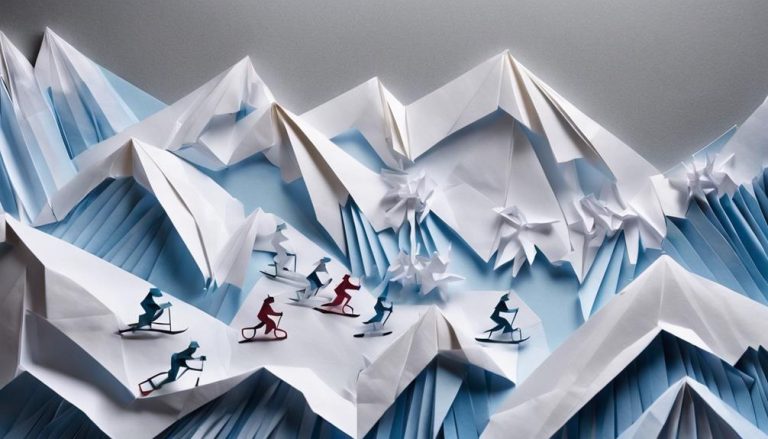General Rules of Super Giant Slalom
As you stand at the starting line, the course stretching out before you like a challenging puzzle waiting to be solved, you may wonder about the general rules that govern Super Giant Slalom. From the intricacies of gate setup to the precision of timing and scoring, each aspect plays a crucial role in the success of the event. But what about the safety protocols in place to protect athletes or the equipment requirements necessary for optimal performance? Let's unravel these regulations together and explore the world of Super Giant Slalom with a keen eye for detail and a spirit of adventure.
Course Layout
When approaching the course layout for Super Giant Slalom, it is crucial to understand the strategic placement of gates and the overall terrain flow. Super Giant Slalom, or Super-G, presents unique terrain challenges that demand a blend of speed control and precise maneuvering. The course is designed to test your ability to navigate through varying terrains while maintaining high speeds.
As you navigate the Super-G course, you will encounter a mix of terrain challenges that will require quick thinking and adaptability. From steep sections that demand expert speed control to flat areas where maintaining momentum is key, each part of the course presents its own set of obstacles. Being able to adjust your technique to match the terrain is essential for a successful run.
Speed control plays a pivotal role in your performance in Super Giant Slalom. While speed is crucial to achieving a competitive time, the ability to modulate your speed when needed can be the difference between a clean run and a disqualification. By mastering the art of speed control, you can glide through the course with confidence, knowing when to accelerate and when to ease off the throttle.
Understanding the terrain challenges and honing your speed control skills are essential components of conquering the Super-G course. By analyzing the course layout and strategizing your approach, you can navigate the twists and turns with finesse, setting yourself up for a successful race.
Gate Setup
The arrangement of gates in Super Giant Slalom is strategically designed to challenge skiers' precision and speed control abilities. Gate positioning plays a crucial role in testing your turn technique and body positioning while maintaining control at high speeds.
In Super Giant Slalom, gates are placed wider apart compared to other alpine skiing disciplines like Slalom or Giant Slalom. This wider gate positioning requires you to employ effective turn techniques to navigate through them efficiently. As you approach each gate, your body positioning becomes key. Leaning into the turn while keeping your upper body stable helps you maintain control and speed through the course.
To excel in Super Giant Slalom, mastering speed control is essential. The gate setup demands a balance between maintaining high speeds and accurately navigating the course. Your ability to adjust your speed before and after each gate is crucial in optimizing your performance. Proper speed management allows you to carry momentum through turns while avoiding penalties for missing gates.
Timing and Scoring
When it comes to Super Giant Slalom, understanding the points system is crucial. Points are awarded based on precise timing methods and a structured scoring system. Familiarizing yourself with how points are calculated will enhance your grasp of the sport's competitive aspect.
Accurate Timing Methods
Implementing accurate timing methods is crucial in ensuring fair competition and precise results in Super Giant Slalom races. To achieve this, consider the following:
- Split Times: Utilize split times to track the skier's performance at different sections of the course.
- Video Analysis: Incorporate video analysis to validate timing data and resolve any disputes that may arise.
- Electronic Timing, Manual Backup: Employ electronic timing systems for efficiency, but always have a manual backup in place to prevent any technical failures from affecting the results.
Scoring System Explanation
To understand the overall performance of skiers in Super Giant Slalom races, it is essential to grasp the intricacies of the scoring system, which encompasses both timing and scoring components. In Super Giant Slalom, the scoring system is crucial for determining the final standings. Below is a breakdown of the points system to help you understand the scoring rules better:
| Placement | Points |
|---|---|
| 1st Place | 100 points |
| 2nd Place | 80 points |
| 3rd Place | 60 points |
| Other Places | Decreasing points |
Understanding how points are awarded based on the skier's placement is vital in following the competition closely. Make sure to keep track of the points earned by each skier to see how they rank in the Super Giant Slalom race.
Safety Protocols
What are the key safety protocols that must be adhered to during Super Giant Slalom races? When participating in Super Giant Slalom races, it is crucial to prioritize safety. To ensure the well-being of all participants, certain safety protocols must be followed:
- Injury Prevention: Emphasize the importance of injury prevention by ensuring that all racers are aware of the risks involved in Super Giant Slalom. Encourage athletes to warm up properly and maintain good physical condition to reduce the chances of injuries.
- Emergency Response: Establish a clear emergency response plan that outlines procedures in case of accidents or injuries during the race. Designate specific individuals responsible for managing emergencies and ensure that all participants are aware of the protocol.
- Safety Checks: Conduct thorough safety checks on equipment, race tracks, and weather conditions before the start of the race. Inspect the course for any potential hazards and address them promptly to minimize risks during the competition.
Equipment Requirements
Ensuring your equipment meets the specified safety standards is essential for participating in Super Giant Slalom races. Adhering to equipment regulations and safety guidelines is crucial to protect yourself and others on the course. When it comes to gear specifications, your skis must have a minimum length of 210 centimeters for men and 205 centimeters for women. The ski's sidecut radius should be at least 45 meters. Bindings need to be properly adjusted to your boots to ensure they release when needed. Helmets are mandatory, and it's recommended to choose one with a hard shell for optimal protection.
Maintenance tips are also vital to guarantee your equipment functions correctly during the race. Regularly check your skis for any signs of damage or wear, and make sure the edges are sharp for better control. Bindings should be inspected to ensure they are in good condition and adjusted according to your weight and skill level. Helmets must fit snugly and be free of any cracks or defects. Additionally, make sure your boots provide proper ankle support and fit comfortably to enhance your performance on the course. By following these equipment requirements and maintenance tips, you can ensure a safer and more enjoyable Super Giant Slalom racing experience.
Penalties and Disqualifications
When it comes to Super Giant Slalom, understanding the points system is crucial. Points are awarded based on performance, with penalties and disqualifications affecting the final score. Familiarize yourself with the penalties and disqualifications criteria to ensure fair competition.
Penalties Explained
Understanding the penalties and disqualifications in Super Giant Slalom is crucial for competitors aiming to achieve success in the sport. In this discipline, penalties are enforced to maintain fairness and discipline among participants. Here are some key points to keep in mind:
- Penalties can result from infractions such as missing gates, deviating from the course, or not following the rules.
- Consequences of penalties may include time additions to the final result or disqualification from the race.
- Enforcement of penalties is done by officials who ensure that all competitors adhere to the regulations to uphold the integrity of the competition.
Disqualifications Criteria
To avoid disqualification in Super Giant Slalom, competitors must adhere strictly to the rules and regulations set forth by the officials. Disqualifications criteria are applied when skiers fail to pass through all the designated gates, miss a gate entirely, or do not ski around a gate in the correct direction. Common mistakes that lead to disqualification include straddling a gate, skiing off a course, or not following the specified route through the gates. It's crucial for participants to maintain control and ski within the boundaries of the course to avoid penalties or disqualification. By staying focused, alert, and precise in their maneuvers, skiers can ensure they complete the race successfully without facing disqualifications.
Starting Procedures
Before commencing the Super Giant Slalom race, athletes must adhere to specific starting procedures to ensure a fair and organized competition. The starting procedures are crucial to maintain the integrity of the race and provide all athletes with an equal opportunity to showcase their skills. Here are some key points to keep in mind:
- Proper Stance: Ensuring you are in the correct stance at the starting gate is essential for a successful start. Your body position should be balanced and ready to propel you forward as soon as the race begins. Maintaining a proper stance can give you a competitive edge right from the start.
- Timing Devices: Pay close attention to the timing devices at the starting gate. These devices are used to measure your start time accurately. Make sure you are familiar with how they work and follow any instructions provided by race officials regarding timing procedures. Precise timing is essential for determining race results and ensuring fairness among competitors.
- Stay Focused: As you prepare to start the race, it's crucial to stay focused and block out any distractions. Visualize your run, concentrate on your technique, and mentally prepare yourself for the challenge ahead. By staying focused, you can improve your chances of a successful start and a strong performance throughout the race.
Athlete Conduct
After adhering to the starting procedures, athletes are expected to maintain a high standard of conduct throughout the Super Giant Slalom race. Sportsmanship, etiquette, behavior, conduct, professionalism, and attitude are crucial aspects of athlete conduct that contribute to the overall atmosphere of the competition and reflect on the individual athlete and the sport as a whole.
Athletes should embody the spirit of sportsmanship by showing respect for their fellow competitors, race officials, and the rules of the event. Displaying good sportsmanship involves accepting both victory and defeat graciously, without belittling others' achievements or behaving in a manner that brings disrepute to the sport. Etiquette on the slopes includes yielding to faster skiers when necessary, not obstructing the course, and being mindful of other racers during warm-up runs.
The behavior of athletes should align with the highest standards of professionalism. This means refraining from any actions that could be considered unsportsmanlike conduct, such as intentional interference with another racer or using disrespectful language towards officials. Maintaining a positive attitude, even in the face of challenges, is a hallmark of a true sportsman.
| Sportsmanship | Etiquette |
|---|---|
| Respect for competitors | Yielding to faster skiers |
| Grace in victory and defeat | Avoiding course obstruction |
| Upholding the spirit of fair play | Consideration for other racers |
| Professionalism | Attitude |
| Positive behavior | Maintaining composure under pressure |
Frequently Asked Questions
Can Athletes Use Their Own Personal Equipment, Such as Skis and Poles, or Are They Required to Use Equipment Provided by the Event Organizers?
You can use your personal skis and poles in Super Giant Slalom. Athletes have the freedom to choose equipment that suits their performance, aligning with their preferences. Regulations allow for this flexibility, enhancing the athlete's experience.
Are There Any Restrictions on the Type of Clothing or Gear Athletes Can Wear During the Race, Such as Helmets or Padding?
In your race down the slope, helmet requirements must be met to compete. Padding options for safety are allowed, ensuring your gear keeps you secure. Choose wisely to glide with confidence down the course.
How Are Tiebreakers Determined in the Event of Two or More Athletes Finishing With the Same Time?
When two or more athletes finish with the same time in Super Giant Slalom, tiebreaker rules come into play. Timing devices measure the racers' times to the nearest hundredth of a second to determine the final rankings.
Are There Any Specific Rules Regarding the Use of Technology, Such as GPS Devices or Heart Rate Monitors, During the Race?
During the race, it's crucial to follow technology regulations for athlete safety and fair competition. Performance tracking tools like GPS devices or heart rate monitors are usually allowed as long as they don't give an unfair advantage.
Are Athletes Allowed to Receive Coaching or Assistance From Coaches or Teammates During the Race, or Must They Compete Independently?
During the race, athletes must showcase their skill independently. Coaching assistance or teammate support is not allowed. Embrace the challenge solo, following race rules with determination. Independence is key to your success on the slopes.






